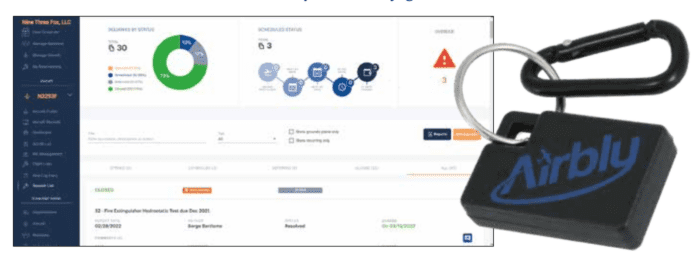Consider that between 30 and 50 percent of the value of older aircraft lies in the aircraft’s technical and journey logs. It’s not just about paper signoffs to keep the aircraft airworthy. Think about all of the time- and date-sensitive components and service events that are documented in the logs.
If the logs are lost, stolen or destroyed, someone will have to pay for replacement parts and inspections already accomplished. And when it’s time to sell, the value of the logbooks rightfully rises to the surface. While the popularity of digital pilot logs is increasing, virtual maintenance records have been slow to evolve. But I found a few good options worth considering, even for supplementing paper logs.
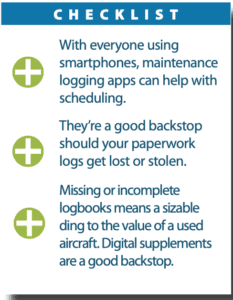
SERVICE LOGGING 101
U.S.-registered aircraft are required to have a single logbook, but logbooks for airframe, engine and propellers are common. There are a ton of FARs related to logbooks (FARs 43.11, 91.411, 413, 417), which require a minimum amount of information for maintenance. This includes the type of inspection, description and date, the aircraft’s total time in service, the mechanic’s name, certificate number and type (IA and A&P, for example) and a signoff. The magic language for signoff is “I certify that this aircraft has been inspected in accordance with (insert type) inspection and was determined to be in airworthy condition.“ If during the inspection, the shop finds anomalies and does not approve the aircraft for return to service, then the wording changes to “… a list of discrepancies and unairworthy items (dated) has been provided for the aircraft owner or operator.” Major repairs and major alterations have their own forms (via FAA Form 337). For the aircraft to be deemed airworthy, the one-time and recurring airworthiness directives must be listed and complied with. FAA Advisory Circular 120-78A provides guidance for electronic record keeping as we’ll as electronic signatures.
NO LOGS? BIG PRICE HIT
VREF Aircraft Value Reference estimates that the quality and completeness of aircraft logbooks could impact the resale price of an aircraft up to 60 percent. Company President Jason Zilberbrand said that typically, an aircraft without logbooks has zero value for commercial purposes and that VREF usually deducts 60 percent of the value of the aircraft for Part 91 operators. Of course, much of this is dependent on the equipment type, and how much of the logs are missing. For a piston aircraft it’s much easier to overcome partial logbooks that are missing. For a turbine aircraft, it’s almost always a very serious issue. You can have logs re-created but that depends on the model, and age. “Generally speaking, if an aircraft is being resold and it has no logs or missing recent logs, then it is not an aircraft a bank will lend on,” Zilberbrand said.
One simple way to calculate the value of lost logbooks would be to determine the time-sensitive components on the airframe or engine and get a price quote for each item, including labor. The number and type of components will vary based upon the make and model of the aircraft being evaluated, but this analysis should be conducted by the seller of the aircraft and may be a motivator to attempt to reconstruct the logbooks, perhaps through information kept by each maintenance provider. It’s a lot of legwork.
PAPER BACKUP STRATEGIES
If you don’t want to move to full-up digital logging, consider copying or scanning the paper logbook entries as soon as possible. As one example (I operate my Rockwell in Canada and maintain Journey logs), the standard Transport Canada Journey logbook is a 11 by 17 inch book, also known as tabloid format. Many photocopiers are able to photocopy onto tabloid paper, and newer photocopiers are able to scan and save to PDF format.
Scanning the technical logs will take much longer, due to the paperwork that A&Ps tend to staple into the logbook. These forms (component overhaul and repair forms, as an example) and should be scanned as well, providing an audit trail for the hardware installed into the aircraft. The bulk of the time effort will be spent with the initial scan, after which a small amount of time is required to update as things change. Mike Busch, founder and CEO of Savvy Aviation, has good advice.
“We tell our clients never to let their aircraft’s logs out of their hands. The owner needs to control their logs to ensure that entries are correct and accurate, and helps stop some shops from holding the logs hostage until a bill is paid,” he said.
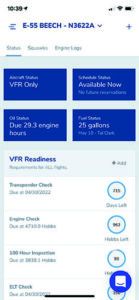
DIGITAL LOGS
The companies I looked at—Airbly, PlaneLogix, Crewchief Systems, Coflyt, Bluetail Aero and Vision Aircraft Records—have cloud-based software solutions designed to digitize your paper logs. Essentially, their systems are databases containing each flight, maintenance entry, JPG images and PDF files. When the system is initially installed, the times for the aircraft, propellers, magnetos, vacuum pumps, last oil change and airworthiness directives are entered. As each flight is logged, maintenance alerts are generated and either emailed or SMS/texted to the individual in charge of maintenance.
Airbly Inc., of Charlottetown PE (Canada), has created a solution to automate the creation of the Journey log and track each flight. Flight entries are automatically created every time the aircraft is flown, using satellite communications, a battery-powered appliance called the Phoenix Aircraft Monitor (PAM), aircrew key fobs, the cloud and a mobile app. Gone are the days of estimating aircraft times via Hobbs meters, tachometers or wristwatches. I really like the elimination of math mistakes in the logbooks. Each flight’s data is stored in the Airbly Cloud and locally on your smart device, which meets Transport Canada’s requirements for a Journey log.
The heart of the system is the PAM, which is about the size of a cigarette package, designed to be placed on the glareshield and completely standalone. The lithium ion battery should deliver roughly 100 hours of flight time. The PAM has onboard GPS, a satellite tracker, gyroscope, accelerometer and temperature and battery-level sensors. The PAM notes engine on/off times based upon vibration and wheels up/down times based upon a complex algorithm considering airspeed, rate of climb/descent, vibration analysis and aircraft stability.
Airbly is accessible through a web browser, iOS and Android apps. The PAM can be paired with your smartphone and will communicate with Airbly’s mobile app. The app is also used for upgrading the PAM’s firmware and accessing your digital log. The first-time setup of Airbly is pretty straightforward, with the PAM shipped pre-configured for your aircraft. For fleet ops, each aircraft would have its own PAM device. Pilots and aircrew are provided with a unique key fob (model T-100), which identifies them to the PAM. Once your Airbly account is created, a few housekeeping tasks are required, including setting up pilot and maintenance profiles, adding the aircraft’s current time and adding in maintenance reminder records. You can manually add historic flights and maintenance entries into the system to completely document the aircraft’s history.
Recurring maintenance records are easily added for a variety of hardware: magneto overhaul hours, propeller overhaul date, airworthiness directives, oil changes, transponder and pitot static certification, ELT battery replacements, etc. As the aircraft’s hours or date comes near to each recurring maintenance item, an email is sent to remind the owner of the upcoming event. Maintenance and avionics shops can log into the aircraft’s account and add a maintenance record. Supporting file uploads, the shop can upload a digital image of its “sticker” including mechanic signatures.
The system includes an aircraft tracking feature that displays the aircraft’s track, altitude, date and time. The PAM utilizes Globalstar’s satellite network, dropping electronic breadcrumbs every five minutes. Airbly pulls ADS-B data from Planefinder (if the aircraft is equipped with ADS-B Out). Once the aircraft is communicating with the ADS-B infrastructure, the data is transferred to Airbly in real time every 30 or 60 seconds. With the PAM communicating over satellite, tracking occurs all the way to aircraft shutdown. A shareable link can be included in your flight plan, aiding Flight Services and Search and Rescue in the event of an overdue aircraft.
Airbly will send the pilots or owner two emails, one containing departure and a second containing arrival information. Included in the arrival email are battery status, the times (engine, air and block), landings, dates, crew, departure/arrival airports and weather. For those who still want to use a paper log, you can use the email to record the times.
Airbly collaborates with technical logbook platforms to allow for API integration. Essentially, when you fly your aircraft, the data is sent to other cloud companies like PlaneLogix, Coflyt and Crewchief. Integration APIs are under development for integration into other log platforms. New features under development include manually closing out a flight from the mobile app (sometimes a satellite message at the end of the flight might not reach the satellites) and automatic app startup using iBeacon technology.
Airbly makes it easy to try out its system. You place your order online, providing your contact information and credit card information. Your first aircraft monitor, two crew trackers and related service fees will be refunded within 60 days if you’re not satisfied with the technology. All aircraft monitors include a one-year warranty.
Airbly’s pricing has two components: hardware and annual subscription. One-time hardware pricing includes: Phoenix Aircraft Monitor for $329, each T100 Crew tracker FOB is $24, a DC power wire is $9 and the satellite activation fee is $39, but is waived on new orders. Airbly has three annual subscription plans: Basic with no aircraft tracking is $79, Lite (which includes 250 hours of satellite logging) is $129 and Unlimited is $299. Annual options include: Lite satellite tracking for $149, Lite ADS-B tracking for $49, unlimited satellite tracking for $199 and unlimited ADS-B tracking for $99. The Phoenix Aircraft Monitor kit (P200) includes the PAM, USB charging cable and mounting brackets.
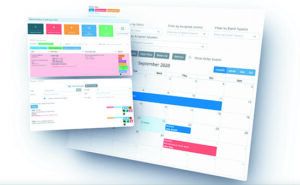
AIRCRAFT/TECHNICAL LOGS
PlaneLogix (www.planelogix.com) was founded in 2014 by Rob Wilkes and Will Goldstein focusing on U.S.-operated aircraft logs. The impetus to create its cloud aircraft record-keeping solution occurred after Rob’s A&P temporarily lost his aircraft’s logbooks. The system is designed to contain your aircraft’s legacy log entries as we’ll as new ones. PlaneLogix is a complete platform, using Amazon’s AWS Cloud computing system to securely process and manage your aircraft’s maintenance data and documents, with updates released on a weekly basis.
There are a number of options to get data into the PlaneLogix system: DIY through scanning the documents and adding each record, sending the scanned documents to PlaneLogix for data entry or sending a paper copy directly to PlaneLogix. PlaneLogix has over 1000 aircraft using its system.
Today, the system is entirely web- based; however, apps for iOS and Android devices are under development and should be released later in 2022. As part of a GA-focused system, PlaneLogix provides reporting, statistics, documents squawks, plus it tracks recurring maintenance, has an aircraft scheduler (maintenance and flights) and a document library. PlaneLogix will enter all of your historic log entries into its system, including scanning the paperwork.
All of the scanning is done inhouse at PlaneLogix’s office using PlaneLogix staff. Some of its customers personally deliver their logs to PlaneLogix rather than trusting them to a shipping company. For those customers who want to send PlaneLogix their original documents, PlaneLogix will provide locked water-tight Pelican cases with a return shipping label. You can also scan the documents yourself and PlaneLogix will take care of entering all the data. For older airplanes, this can take a lot of time.
The system is we’ll laid out with a Home screen (think of it as a dashboard), which indicates the maintenance status of the aircraft and next maintenance items due. The dashboard has simple click buttons that drill down into the details of each item. The Document Uploader provides a simple methodology to upload and OCR any documents and categorize them, using a drop-down list for an airworthiness certificate and borescope analysis, to name a couple of typical examples. You then simply drag and drop the files into a box for upload.
AD compliance can be accomplished three ways using the system. The best way is to link to a maintenance entry (like a 100-hour inspection) and scan or add a signature. You could also use an AD compliance report created by the A&P, which is scanned and OCR’d into the system (this is a common method used by A&Ps). You could add a maintenance free-form entry, but this would require extra steps for compliance verification. OCR’ing the document allows you to open the document (in the Documents page) and search the document for a specific text. OCR’ing only works with text documents—not handwritten documents.
Caiolinn Ertel, a Cessna 414 owner, attests that her airplane is complex with a long maintenance history. She found it so difficult to keep track of maintenance items and wasn’t sure everything was in order (it turned out the props had a lot more hours on them than she thought). “I flew my logbooks down (not far for me) and they returned them in four days. There were two ADs that were out of compliance and thankfully they were easy inspections. The A&P or I upload new entries and they automatically update everything, and check to ensure the wording is correct for FAA compliance. Now I have paper logbooks and 100 percent accurate electronic copies as well,” she said.
PlaneLogix has four annual pricing plans for single-engine piston aircraft operating as Part 91: DIY which is free, but limited to 10 records (think of it as a try-before-you-buy plan), DIY Plus at $249.95, Pro at $499.95 and Ultimate at $749.95. If your aircraft is a turboprop or jet, add $100/$200 to the Pro and $50/$150 to the Ultimate plans (respectively). For Part 135 or flight schools, for piston, turbine or jet aircraft, add $230/$200/$300 to the Ultimate plan. PlaneLogix offers monthly plans, but the annual plan saves you 20 percent.
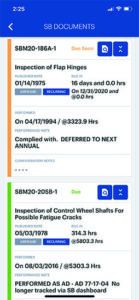
Crewchief Systems (www.crewchiefsystems.com) was founded in 2018 by Aaron de Zafra, a private pilot and a Mooney owner. His vision was creating a cloud-based aircraft asset intelligence system. After spending over two years in development, the system was launched in late 2020. Crewchief caters to owners and maintenance shops (called affiliates), but will be adding flight schools soon. To date there are 200 aircraft and six maintenance affiliates on the platform. With 17 employees, Crewchief has been busy adding more modules to its system. Using Google Cloud for its backend platform (for nonstop access to secure data), Crewchief’s expansion leverages its maintenance affiliates who promote Crewchief to its aircraft customers. The system has the added benefit of providing the pilot with a strong situational awareness of the aircraft’s regulatory compliance, manufacturer service bulletin compliance and other maintenance activities.
Other modules have been developed and are in testing to expand the system to its vision of being an aircraft asset intelligence platform. Crewchief has a reservation system focused on flight schools in beta testing. Extending the reach of the system, a digital flight tracking module will integrate into the aircraft’s digital cockpit, downloading engine data directly into Crewchief. The module is expected to be completed later in 2022.
Crewchief MX Pro is designed for maintenance shops, providing a multi-aircraft view into the system. The frontline mechanic can log in to MX Pro using a tablet or laptop computer, right at the aircraft he or she is working on. Access to the aircraft ADs, SBs and maintenance documents (manufacturer’s 100-hour inspection list, as an example) will allow the shop to save time, which should theoretically reduce the hours billed to the aircraft owner.
Aaron de Zafra, Crewchief’s CEO, said maintenance shops can spend up to 40 percent of their time researching and reviewing historical aircraft records. The idea is for Crewchief to make this process more efficient for the service provider, and may substantially reduce the cost of annual inspections and other maintenance events, according to de Zafra.
Crewchief Systems has both annual and monthly plans, but you’ll save 15 percent if you subscribe to an annual plan. The annual subscriptions, per aircraft, for single- engine, twin-engine and turbine aircraft are $499/$799/$899 respectively. Crewchief has yet to finalize a subscription price for MX Pro used by maintenance shops.
Coflyt (www.coflyt.com) in Pensacola, Florida and Starkville, Mississippi, is perhaps the most cost effective of my reviewed digital aircraft log systems. The company founders, Tal Clark and Eric Hill, both own aircraft and found the need for a better solution to GA aircraft management, which led to the creation of Coflyt in May of 2019. The system supports a web browser as we’ll as a mobile app (iOS and Android).
The software has a free version, which will support one aircraft and one user. The “Individual” free subscription allows for adding inspection maintenance activities and flights and viewing the log history. If you want more advanced functionality, upgrading to the Premium Individual subscription is required, which provides A&P access, unlimited maintenance entries, FAA-compliant digital logs, import of ADs from the FAA, document uploads, fuel and oil tracking and SMS/email notification, to name a few.
As with the other products reviewed here, Coflyt does much more than aircraft maintenance, including reservations and scheduling, managing costs and payments from owners, and aircraft status and flight readiness. The system is designed around GA Part 91 and Part 135 operators, with different pricing structures based upon the category. The software is pretty intuitive to use, both through the web and the mobile app. I installed the app on my older iPad Pro and the software was not only formatted to support landscape, but it used all of the iPad’s screen (a pet peeve of mine is some vendors who port their smartphone mobile app to a tablet, without rewriting the app to support the larger screen size). I was delighted to see that the performance of the app on my old iPad was pretty perky.
From a payment processing perspective, Coflyt uses Stripe for credit card transactions. This is ideal from a partnership and block-time perspective, using credit cards to deal with collecting costs. Gone are the days of chasing owners and block timers down for checks or cash.
Coflyt has a free subscription, which is really a try-before-you-buy deal. The free version has a lot of the capability greyed out, which is perfect to show you what you get if you upgrade. There are three different pricing categories, starting with Individual, with an annual subscription at $140 (you get two months free versus the monthly subscription). The Individual paid subscription supports one aircraft and one user (pilot) and allows A&Ps to access the system. For Part 91 aircraft partnerships, the annual subscription is $360 (again with two months free versus the monthly subscription). One aircraft, an A&P and unlimited users can be added to the system. Each additional aircraft is $150 per year. Part 91 turbine aircraft and Part 135 operators should contact Coflyt for pricing.
Vision Aircraft Records (www.visionaircraftrecords.com) was founded in 2010 by Larry Hinebaugh (an A&P and IT guru). The software platform has between 325 to 400 aircraft and focuses on business aviation operators. The system supports a web browser; however, a major release is in the winds (60 to 90 days), which will include iOS and Android apps. The system is not a maintenance management system, but focuses on the electronic log record-keeping problem. Company CEO Mark Lepper reiterated that the FAA requires that Part 135 operators present logs on the spur of the moment, while FSDOs can ground the aircraft if the paperwork is not available.
“FAR 43.12 addresses the importance of maintaining a chain of custody for paper records. Leaving your logs at a local print shop for scanning would break that chain of custody which the FAA requires,” Lepper said. Meeting the demands of Part 135 operators, the system has pricing focused on GA operators as we’ll as heavy jets. Vision Aircraft Records offers a complete end to end solution, inclusive of scanning and OCR’ing paper logs. They are different from the rest of the pack, coming to your hangar with large-format scanners to scan all of the paperwork with a network of contractors/employees spread across the U.S. A typical customer requires one to seven days to scan and organize the logs. Some owners fly their logs to one of Vision’s seven sites, but Vision recommends that they conduct the scanning at the aircraft’s home airport. For GA owners on a budget, they offer a DIY service for log scanning. Vision has seen an abundance of shoddy logs and has gained experience in auditing logs, while helping customers enhance the aircraft’s records by transitioning to digital. Vision’s goal is to advocate a mass transition to electronic digital records.
Vision offers a free 30-day trial before committing to a monthly or annual subscription. The pricing is based upon four types of aircraft (annual subscription after a 15 percent discount) and is per aircraft with unlimited users. A piston singles subscription is $703.80 with an onboarding fee of $299, a light jet/turboprop sub is $1315.80, mid-sizes jets are $1825.80 and heavy jets are $2335.80. All but the piston single tiers have an onboarding fee of $999. The fee does not include scanning services. A typical banker’s box of records could require one day of scanning at a rate of $500 per box (plus travel expenses). Vision’s logbook audit service is conducted on a fee-for-service basis at $250 per hour. A monthly subscription is available, but most customers subscribe to annual plans. Fleet owners should call for discounted pricing.
Bluetail (www.bluetail.aero) was founded in 2020 by Roberto Guerrieri and Stuart Illian. Bluetail utilizes Amazon’s AWS Cloud storage and computing infrastructure to deliver nonstop and secure framework to safeguard your aircraft’s logs. With FAR 43.12 compliance, no delete option and nightly data backup, you can rest assured that your digital records will not evaporate into the ether of the World Wide Web. Bluetail’s onboarding approach scans and utilizes machine learning to index each log entry and document. Records from maintenance applications like CAMP can be uploaded directly into Bluetail, saving time. A network of over 120 corporate-focused secure locations are used to scan the logs into Bluetail, but Bluetail will come to you. The intellectual property surrounds their OCR and indexing capability including OCR’ing handwriting with a high success rate. While the system is completely browser based, they are working on iOS and Android mobile clients. The company said customers come to Bluetail for protecting the aircraft’s value, the maintenance time efficiencies gained through OCR and searchability and data sharing. By year’s end, the goal is to have over 1000 aircraft on their platform. With a capital injection of $2 million from an equity partner, they have scaled quickly with 23 employees, contractors and consultants.
Bluetail’s pricing has an annual subscription fee and one-time fee for the following categories: Single or twin-engine piston is $744, plus a $199 one-time fee; light jet and turboprops are $1086, plus a $299 one-time fee; mid-sized jets are $1608, plus a $399 one-time fee; and large-cabin jets are $2688, plus a $499 one-time fee. An annual subscriptions offer a 10 percent savings over a monthly plan. The one-time fees exclude scanning costs.
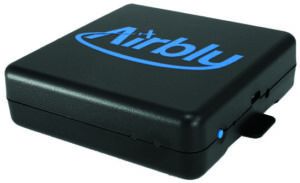
CONCLUSION
Over the years, I have found small math errwors when adding time flown to total air time. After a long flight, up early, too much coffee, hot, dehydrated, hungry and brain fried, I can be challenged with second grade math. I like that Airbly takes the guesswork out of time computations, accurately recording both air and flight times.
I really like the maintenance reminders, keeping a running log on when I need to change the oil, IFR certifications and magnetos inspections and overhauls.
Aircraft records tell a story about the history of the aircraft, how we’ll it has been maintained and its general condition. The more detailed the records, the more valuable the aircraft becomes. Protecting this history is not only good stewardship (after all, with older aircraft, we’re just caretakers), but may deliver future rewards, which are priceless.
Check out the conversation with Will Goldstein, co-founder of PlaneLogix, on the “PlaneTalk” podcast, on Apple, Google, Spotify and at www.PlaneTalk.ca.
Contributor Phil Lightstone is an aviation author and flies a Rockwell Commander based in Canada.

